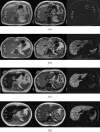Iron overload: accuracy of in-phase and out-of-phase MRI as a quick method to evaluate liver iron load in haematological malignancies and chronic liver disease
- PMID: 21385919
- PMCID: PMC3474105
- DOI: 10.1259/bjr/22327146
Iron overload: accuracy of in-phase and out-of-phase MRI as a quick method to evaluate liver iron load in haematological malignancies and chronic liver disease
Abstract
Objectives: The purpose of this prospective study was to evaluate the accuracy of in-phase and out-of-phase imaging to assess hepatic iron concentration in patients with haematological malignancies and chronic liver disease.
Methods: MRI-based hepatic iron concentration (M-HIC, μmol g(-1)) was used as a reference standard. 42 patients suspected of having iron overload and 12 control subjects underwent 1.5 T in- and out-of-phase and M-HIC liver imaging. Two methods, semi-quantitative visual grading made by two independent readers and quantitative relative signal intensity (rSI) grading from the signal intensity differences of in-phase and out-of-phase images, were used. Statistical analyses were performed using the Spearman and Kruskal-Wallis tests, receiver operator curves and κ coefficients.
Results: The correlations between M-HIC and visual gradings of Reader 1 (r = 0.9534, p < 0.0001) and Reader 2 (r = 0.9456, p < 0.0001) were higher than the correlations of the rSI method (r = 0.7719, p < 0.0001). There was excellent agreement between the readers (weighted κ = 0.9619). Both visual grading and rSI were similar in detecting liver iron overload: rSI had 84.85% sensitivity and 100% specificity; visual grading had 85% sensitivity and 100% specificity. The differences between the grades of visual grading were significant (p < 0.0001) and the method was able to distinguish different degrees of iron overload at the threshold of 151 μmol g(-1) with 100% positive predictive value and negative predictive value.
Conclusion: Detection and grading of liver iron can be performed reliably with in-phase and out-of-phase imaging. Liver fat is a potential pitfall, which limits the use of rSI.
Figures

Similar articles
-
Diagnostic accuracy of dual-echo (in- and opposed-phase) T1-weighted gradient recalled echo for detection and grading of hepatic iron using quantitative and visual assessment.Eur Radiol. 2014 Jul;24(7):1437-45. doi: 10.1007/s00330-014-3170-5. Epub 2014 May 1. Eur Radiol. 2014. PMID: 24788037
-
Evaluation of liver iron overload with R2* relaxometry with versus without fat suppression: both are clinically accurate but there are differences.Eur Radiol. 2020 Nov;30(11):5826-5833. doi: 10.1007/s00330-020-07010-5. Epub 2020 Jun 13. Eur Radiol. 2020. PMID: 32535737
-
Hepatic iron deposition in patients with liver disease: preliminary experience with breath-hold multiecho T2*-weighted sequence.AJR Am J Roentgenol. 2009 Nov;193(5):1261-7. doi: 10.2214/AJR.08.1996. AJR Am J Roentgenol. 2009. PMID: 19843739
-
Fat and iron quantification in the liver: past, present, and future.Top Magn Reson Imaging. 2014 Apr;23(2):73-94. doi: 10.1097/RMR.0000000000000016. Top Magn Reson Imaging. 2014. PMID: 24690618 Review.
-
Single spin-echo proton transverse relaxometry of iron-loaded liver.NMR Biomed. 2004 Nov;17(7):446-58. doi: 10.1002/nbm.905. NMR Biomed. 2004. PMID: 15523601 Review.
Cited by
-
Usefulness of two-point Dixon fat-water separation technique in gadoxetic acid-enhanced liver magnetic resonance imaging.World J Gastroenterol. 2015 Apr 28;21(16):5017-22. doi: 10.3748/wjg.v21.i16.5017. World J Gastroenterol. 2015. PMID: 25945017 Free PMC article.
-
Impact of body fat composition on liver iron overload severity in hemochromatosis: a retrospective MRI analysis.Radiol Med. 2025 Feb;130(2):179-189. doi: 10.1007/s11547-024-01930-8. Epub 2024 Nov 22. Radiol Med. 2025. PMID: 39578337 Free PMC article.
-
Pancreatic iron quantification with MR imaging: a practical guide.Abdom Radiol (NY). 2022 Jul;47(7):2397-2407. doi: 10.1007/s00261-022-03552-y. Epub 2022 May 21. Abdom Radiol (NY). 2022. PMID: 35596775 Review.
-
Morphometric changes and imaging findings of diffuse liver disease in relation to intrahepatic hemodynamics.Jpn J Radiol. 2020 Sep;38(9):833-852. doi: 10.1007/s11604-020-00978-6. Epub 2020 Apr 28. Jpn J Radiol. 2020. PMID: 32347423 Review.
-
Diagnostic accuracy of dual-echo (in- and opposed-phase) T1-weighted gradient recalled echo for detection and grading of hepatic iron using quantitative and visual assessment.Eur Radiol. 2014 Jul;24(7):1437-45. doi: 10.1007/s00330-014-3170-5. Epub 2014 May 1. Eur Radiol. 2014. PMID: 24788037
References
-
- Brittenham G, Badman D. Noninvasive measurement of iron: report of an NIDDK workshop. Blood 2003;101:15–9 - PubMed
-
- Andrews N. Disorders of iron metabolism. N Engl J Med 1999;341:1986–95 - PubMed
-
- Adams P. Review article: the modern diagnosis and management of haemochromatosis. Aliment Pharmacol Ther 2006;23:1681–91 - PubMed
-
- Alústiza J, Castiella A, De Juan M, Emparanza J, Artetxe J, Uranga M. Iron overload in the liver diagnostic and quantification. Eur J Radiol 2007;61:499–506 - PubMed
-
- Angelucci E, Brittenham G, McLaren C, Ripalti M, Baronciani D, Giardini C, et al. Hepatic iron concentration and total body iron stores in thalassemia major. N Engl J Med 2000;343:327–31 - PubMed
MeSH terms
Substances
LinkOut - more resources
Full Text Sources
Medical

